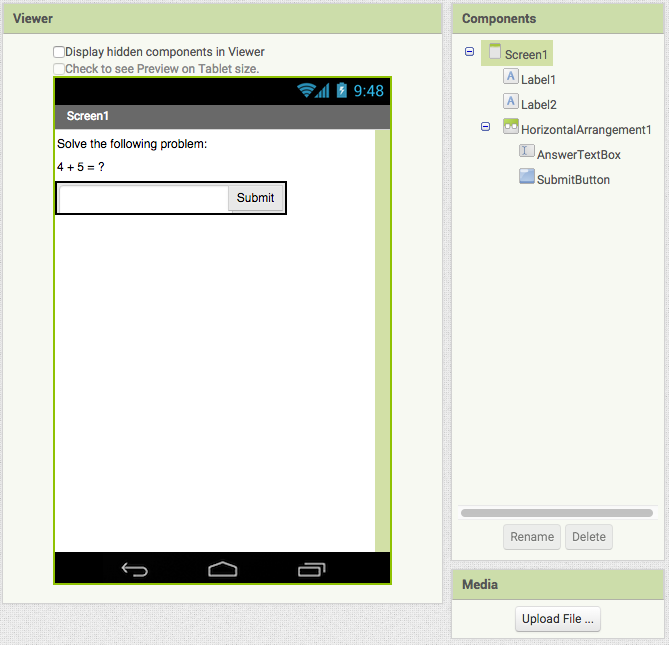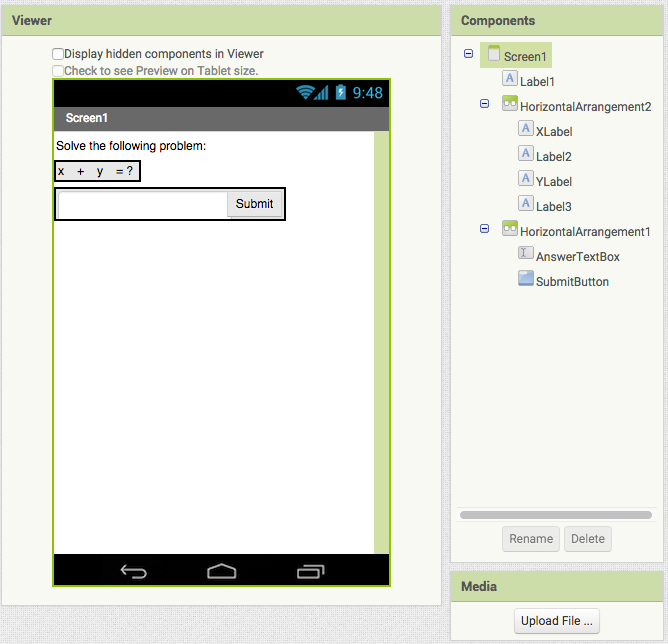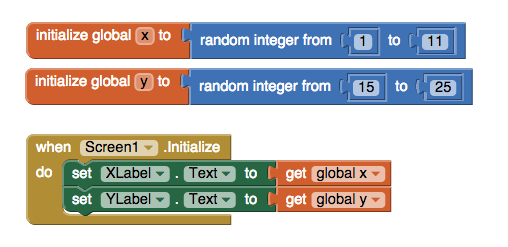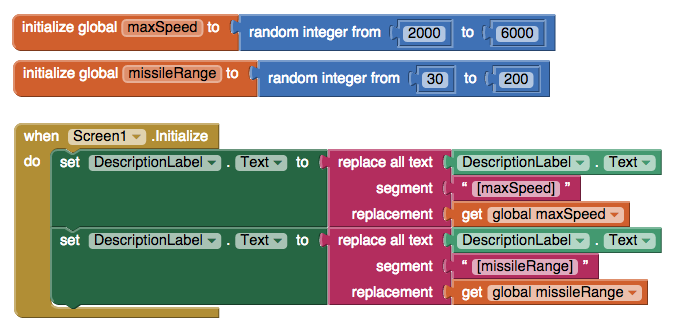Math¶
Now it's time to put some of the skills you acquired to tackle some basic math problems. Create a new project in App Inventor and name it "Addition". Build the screen shown in the following image:

Exercise
Add some behavior to your program to check that the user entered the correct answer and congratulate her if she did. If her answer wasn't correct, give her a note of encouragement.
OK, that's not very interesting, right? Every player will solve the same math problem every time they use your app. Let's make it so that the two numbers are random. First, let's rearrange the screen like so:

Now, go to the Blocks interface and add the following blocks to your program:

Run your app and observe that the numbers are different every time you refresh.
Exercise
Change the logic in your program so that when the user clicks the Submit button, her answer is checked against the value of x + y. Let the player know if she got the answer right or wrong.
Exercise
App Inventor has a lot of math-related blocks, so you can make the math
problem as complex as you want. Change the math problem in your program
to use a different math operator (e.g. divide, multiply, power, etc.).
Exercise
Even the best of us can make occasional errors in our arithmetic. Show a different note of encouragement if the player's answer is off by 1, perhaps: "Your answer is not correct, but it's very close!"
if block, and the absolute block.App Inventor can be used for much more than just numerical computation problems. You can also use it to make randomized word problems! Here's the word problem we will implement:
Godzilla has returned, and she's beating the crap out of Tokyo (again)! Unluckily for Tokyo, there isn't anyone around to stop her, as Ultraman is on his honeymoon while Sailor Moon is on maternity leave. The mayor of Tokyo, in desperation, calls up Pope Francis. Fortunately, his Holiness is prepared for just such an occasion, and immediately scrambles his Popejet, which has a maximum speed of [maxSpeed] km/hr and air-to-surface missiles capable of hitting targets [missileRange] km away. Assuming the distance between the Vatican and Tokyo is 9,850 km, how many minutes will it take for the Pope to get within targeting distance of Godzilla?
Create a new project called "Popejet" and make the screen look like this:

Note here that we didn't split up the description into separate labels.
This would be awkward because of how long the description label needs to
be to hold all that text. Instead, you can put the variable names inside
square brackets, and then, inside the Screen1.Initialize block, replace the variable names with their numerical values:

Tip
Because of how large the amount of text is, it might take up so much space that when you try to type an answer into the textbox, the keyboard covers up the textbox. To avoid this problem, check the Scrollable checkbox in the Properties sidebar for Screen1.
Run the app to see that both [maxSpeed] and [missileRange] are replaced with random numbers in the description label.
Exercise
Add the logic in Blocks to check that the user submitted the correct answer to the problem. To compute the answer, you need to consider this equation:
maxSpeed * timeInHours - missileRange = 9850
round block, found in the Math group.Exercise
Inside the Screen1.Initialize block you have a little bit of redundancy.
Add a new procedure called setDescriptionValue that takes two
inputs, segment and replacement, which can take the place of a set DescriptionLabel.Text block.
This is how you would begin setting up the setDescriptionValue procedure block:

Congratulations, you've completed all of the core chapters in this tutorial. You can now do the other chapters in any order that you like, based on your own interest. You can also just start building your own puzzle hunt!